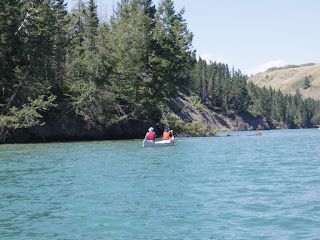According to researchers at Oregon State University and the University of British Columbia who looked at pregnancy and birth outcomes in more than 64,000 singleton births in Vancouver, British Columbia, women who live within 100 meters of green space such as trees, lots of grass, and other plant life tend to have better pregnancy results.
In particular, pregnant women who spend more time in green
spaces are more likely to deliver full-term and higher birth-weight babies. The
researchers believe these positive outcomes of green exposure are related to
the overall health benefits of spending time in nature, including perhaps reduced blood pressure, stress reduction and lower cortisol levels, as well as the fact
that spending time in nature facilitates social support and a sense of
belonging (which, as I write about in Field Exercises, has been a very clear benefit for veterans).
Perhaps this helps account for my recent delivery of a full-term, nine-pound baby? (Now you know why I haven't been posting much lately!)
Although the researchers suggest that neighborhood greenness is an important factor (probably because it allows women to easily spend time outdoors), I suspect that any pregnant woman could easily adapt this research to her own life, no matter what type of neighborhood she lives in. It may take more effort, but it would be well worth seeking out and spending time in a park or by the river as much as possible during one’s pregnancy – and afterwards, too. It certainly can’t hurt!
What I’d like to see now is a study on infant sleep and green exposure. When my son was six months old, I came to realize that the more time he spent outdoors during the day, the better he slept at night. This time around, I’m spending as much time as possible with my baby outdoors. It can’t hurt, and if it benefits her nighttime sleep, then all the better!
Perhaps this helps account for my recent delivery of a full-term, nine-pound baby? (Now you know why I haven't been posting much lately!)
Although the researchers suggest that neighborhood greenness is an important factor (probably because it allows women to easily spend time outdoors), I suspect that any pregnant woman could easily adapt this research to her own life, no matter what type of neighborhood she lives in. It may take more effort, but it would be well worth seeking out and spending time in a park or by the river as much as possible during one’s pregnancy – and afterwards, too. It certainly can’t hurt!
What I’d like to see now is a study on infant sleep and green exposure. When my son was six months old, I came to realize that the more time he spent outdoors during the day, the better he slept at night. This time around, I’m spending as much time as possible with my baby outdoors. It can’t hurt, and if it benefits her nighttime sleep, then all the better!
Reference
Perry Hystad, Hugh W. Davies, Lawrence Frank, Josh Van Loon, Ulrike Gehring, Lillian Tamburic, and Michael Brauer. Residential Greenness and Birth Outcomes: Evaluating the Influence of Spatially Correlated Built-Environment Factors. Environmental Health Perspectives, 2014; DOI: 10.1289/ehp.1308049







